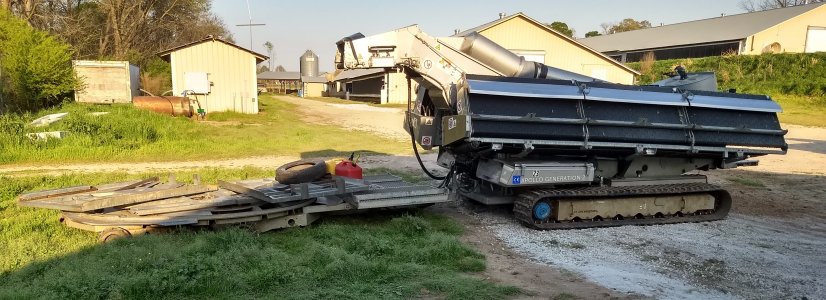simme
Old Dumb Guy
This is a machine I had not seen before. Used on the farm.


The two wings on each side fold out into the front and becomes a 30 foot "combine head" for harvesting chickens while driving through the chicken house. Each "wing" has a belt that rotates to move the chickens to the back of the "header" where there is another belt that move the chickens to the center of the machine, then an inclined belt though the machine that delivers the chickens out a "discharge spout" on the back. The little "trailer" behind is a turntable that hold two 8 foot wide (truck width) multi-story cages that come off the semi trailer empty and goes back on loaded with chickens. Workers ride on the back of the machine and "direct" the chickens into the cages. A loader brings an empty cage off the truck and takes the loaded one back to the truck. Machine is remote controlled by a guy walking beside it.
Previous method was to herd the chickens closer together with the house lights very very dim. Chickens sit down and a catch crew would stoop down, pick them up by the feet with several chickens in each hand and then place then in those same cages. I guess the new machine is faster, shows up on time and gets the job done. I have not seen it in operation. My brother says it is quick.
If you have never seen a "chicken catching" and loadout, it is something else. Several tractor trailers coming and going in a small lot. They only know one speed - fast and furious. Loader going in and coming out (in reverse) of the house at max speed. You don't want to be walking around the loadout area. Often done at night in the dark. You can sense that you are out of place if you are too close to the action.


The two wings on each side fold out into the front and becomes a 30 foot "combine head" for harvesting chickens while driving through the chicken house. Each "wing" has a belt that rotates to move the chickens to the back of the "header" where there is another belt that move the chickens to the center of the machine, then an inclined belt though the machine that delivers the chickens out a "discharge spout" on the back. The little "trailer" behind is a turntable that hold two 8 foot wide (truck width) multi-story cages that come off the semi trailer empty and goes back on loaded with chickens. Workers ride on the back of the machine and "direct" the chickens into the cages. A loader brings an empty cage off the truck and takes the loaded one back to the truck. Machine is remote controlled by a guy walking beside it.
Previous method was to herd the chickens closer together with the house lights very very dim. Chickens sit down and a catch crew would stoop down, pick them up by the feet with several chickens in each hand and then place then in those same cages. I guess the new machine is faster, shows up on time and gets the job done. I have not seen it in operation. My brother says it is quick.
If you have never seen a "chicken catching" and loadout, it is something else. Several tractor trailers coming and going in a small lot. They only know one speed - fast and furious. Loader going in and coming out (in reverse) of the house at max speed. You don't want to be walking around the loadout area. Often done at night in the dark. You can sense that you are out of place if you are too close to the action.
